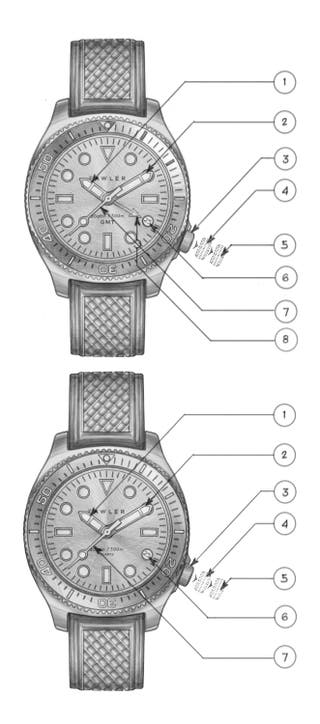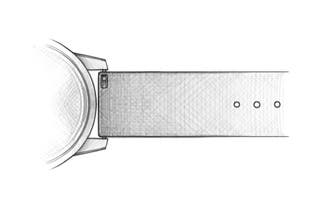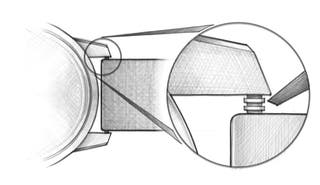The Alon Manual

Instructions
- Hour hand
- Minute hand
- Crown
- Crown - first click
- Crown - second click
- Date window
- Second hand
- GMT hand
Set the time Move the crown to position 5 and turn (remember the 24-hour cycle).
Set the date* Move the crown to position 4 and turn clockwise.
Set the GMT time Move the crown to position 4 and turn counterclockwise.
* The date can be corrected during the day-changing phase between 10 pm and midnight. The date of the following day has to be set, however, as the date will not automatically change at midnight.
Specifications
- Movement: Swiss Ronda 515 GMT quartz
- Water resistance: 30 ATM / 300 m / 1000 ft
- Features: Japanese lumen, Swiss movement, GMT function.
- Battery: Renata 371
- Crystal: Domed sapphire glass with anti-reflective coating
- Case material: 316L stainless steel
- Strap material: Rubber
- Nickel free: Yes
- Max. wrist size: 8 1/4" (21 cm)
- Min. wrist size: 6 1/8" (15.5 cm)
- Strap width: 4/5" (20 mm)
- Case diameter: 1 5/8" (42 mm)
- Dial diameter: 1 1/3" (30 mm)
- Case thickness: 1/2” (13 mm)
- Crown height: 1/5" (4 mm)
- Lug width: 7/8" (22 mm)
- Lug to lug: 1 7/8" (48 mm)
- Weight: 3.1 oz (88 g)
HOW TO TAKE CARE OF YOUR WATCH
WATER RESISTANCE
Most watches have some level of water resistance. If your watch isn’t water resistant, it may be able to handle small splashes, but don’t risk it. If it has a leather strap, don’t get it wet.

1 ATM / 10 meters This watch can't withstand any contact with water.

3 ATM / 30 meters This watch can easily cope with rain and splashes of water.

5 ATM / 50 meters This watch is safe to wear in the shower or while swimming.

10 ATM / 100 meters This watch is water resistant enough for snorkeling.

20+ ATM / 200+ meters This watch is safe for any underwater activity, like scuba diving.
How to clean your watch case
- Do not move the crown or push any buttons when your watch is in contact with water, as this may let water enter the case.
- If your watch is not water resistant, dip a cotton swab in a bowl of warm water with a drop or two of soap in. Squeeze the tip of the cotton swab to remove most of the water and gently rub the case.
- If your watch is water resistant, soak a soft cloth in a bowl of warm water with two drops of mild washing-up liquid added. Wring most of the water out of the cloth and gently rub the case with it.
How to clean your rubber or silicone watch strap
The reason rubber and silicone straps are so popular among men who lead active lifestyles is that they repel both dirt and liquid, so they require very little maintenance, keep their shape and color for a long time, and won’t smell like some absorbent materials will.
- If your watch is water resistant, rinse the whole watch with room temperature water.
- If your watch is not waterproof or water resistant, remove the strap from the case before following these instructions.
- Keeping the case above the surface, submerge the strap in warm, soapy water for a few minutes. Do not submerge the case as this may deform the springs and gears, causing it to become inaccurate or stop working entirely.
- Rinse the watch again with room temperature water and rub off any grime or dirt with a soft brush or your fingers.
- Pat your watch dry with a soft towel to prevent staining and let it air dry through the night.
How to care for your watch
- Store your watch in a dark, dry place to avoid corrosion and discoloration of the dial.
- Always replace the battery on a quartz watch as soon as it runs out. With time, an empty battery may start leaking, damaging the watch’s movement.
- Run mechanical watches at least two days a year to prevent gears and cogs from sticking.
- You should always get your watch serviced by a professional every 3 years.
GENERAL CARE
Rule of thumb: Make sure your watch is the last thing you put on and the first thing you take off. - Take your watch off and store it safely before engaging in any activity that could damage it. - Take it off before engaging in any activity likely to make you sweat. - Take it off before you shower, bathe, or go for a swim. - Take it off before cooking or cleaning. - Take it off before you go to bed. - Don’t expose your watch to chemicals such as cologne, sunscreen, perfume, chlorine, hair gel, etc., as these can discolor, stain, or dull surfaces. - Try to store your watch separately in a soft enclosure to prevent scratching and rubbing. - If your watch has closures or clasps, close these to prevent tangling. - Keep your watch stored in a dry, dark place, and avoid heat fluctuation.
How To Remove A Watch Strap & Replace With A New One
To remove and change your watch strap, you’ll need:
- The watch
- A replacement strap
- A soft surface such as a cloth, t-shirt, or mouse pad
You may also need:
- A spring bar tool
- Or a sharp pointed object
HOW TO REMOVE A WATCH STRAP
- Place your watch on a soft surface. This prevents it from getting scratched or damaged.
- If your watch has quick-release pins on the underside, push the small lever inward to release the strap.

- If your watch has drilled lugs – small holes in the lugs extending from the main watch case – use a sharp, pointed object to push the spring bar in and release the strap. Be careful that the spring bar doesn’t slide out of the strap and get lost.

- If your watch strap has neither of these, use a spring bar tool. This is a small tool with a v-shaped tip. Use it to compress the spring bar from the underside of the strap between the lugs on the right. Using the tool, push down the ridge of the spring bar to release the strap.

HOW TO REPLACE A WATCH STRAP
First, check the lug width of your new watch to verify that it’s 7⁄8” (22 mm). You can find all our watch straps here. Using the filters, select only the matching width to see our selection for your watch.

If your replacement strap has quick-release bars, press the bar inward and slot it into place between the lugs. You’ll feel it ‘lock’ into position. If your new strap doesn’t have quick-release pins, use the spring bar tool again. Place one end of the pin into place, then use the tool to compress the spring bar as you slot it in place. You’ll feel it ‘lock’ in position. Remember to take your time and be careful not to scratch the lugs or damage the new watch strap.
Troubleshooting & FAQ
If you take care of your watch and keep it stored correctly, you should enjoy years of timekeeping precision. But even with the best care possible, you may find that your watch needs extra attention from time to time.
Take a look at common issues with watches here. If you can’t find what you’re looking for, our great Customer Service Team is only a phone call away.
If your new watch isn’t running, make sure you’ve removed the plastic piece between the crown (the knob on the side) and the case. Remove it and push the crown into its normal position.
Check if you need to replace the battery. Some quartz watch batteries can last up to 3 years, but most batteries are only good for 2. Any local professional can do a battery replacement.
The best way to avoid water getting into the watch case is never to operate the buttons or turn or pull the crown out in wet conditions. Even if your watch is water resistant or waterproof, humidity can get into the case as these parts move. Always make sure to close the crown properly before exposing your watch to water.
If you have droplets forming on the inside of the crystal or the crystal looks foggy, open the crown and place the watch in direct sunlight with the crown facing up and the dial facing the sun. Leave it this way for a few hours. If it’s a quartz watch and it has stopped working, the movement may be damaged beyond repair. Take it to your local professional for diagnosis and repair.
This usually means that a gear inside the watch isn’t working properly even though the electronic part is working. The watch needs to be serviced to get it running again. We recommend a service check from your local professional.
This is fixed by replacing the battery. It’s caused by a feature that indicates when the battery power is low. It’s your watch’s way of telling you that the battery is losing power. Any local professional can do a battery replacement.
Using extra functions (like the chronograph) can shorten the battery’s life. To conserve power, only use these features when you need them.
Opening the watch back unnecessarily can compromise the seal of the watch and its water resistance. We recommend only replacing the battery and opening the watch when necessary. Any local professional can do a battery replacement.
The battery should last for 1-2 years. The actual time depends on how many complications (functions like the alarm and stopwatch) the watch has, how often you use them, and how old the watch is.
Dropping or hitting the display can damage the circuits. Water or even the humidity in the air can also cause corrosion. When this happens, parts of the display will not receive proper voltage and cause the digits to not display correctly. A local professional can replace the display.
This is usually a matter of calibrating the chronograph. Rarely is this a case of the watch being faulty. Manually resetting the chronograph hand to 0 should solve the issue.
This is because the analog (the hands) and digital components of your watch are built separately. One can malfunction while the other works fine. Seek a local professional’s help for repair.
2-YEAR WARRANTY
To keep the warranty on your watch valid, don't expose it to water past the rated limit and make sure you keep the receipt.

Other categories
You thought we only sold watches? We've got more than 6.000 products spread over 21 categories of men's accessories. Explore some of them below.







